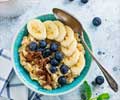- Honey is a complex composition of sugars, organic acids, enzymes, proteins, amino acids, minerals, vitamins made by honeybees from the nectar of flowers
- Honey has been used in alternative medicine for centuries //
- Honey is used for wound healing, coughing, skin care, and for its antimicrobial, anti-aging, anti-cancer and anti-diabetic properties
Honey for Nutrition and Health: A Review
Go to source).
Some benefits of this super-food are:
Honey and Cough:
Honey can be used as a safe cough remedy. It has also proven to be safe for small children with upper respiratory infection.Studies have shown that honey has an excellent safety profile and beneficial effects on the cough prevention (2✔ ✔Trusted Source
Effect of honey on nocturnal cough and sleep quality: a double-blind, randomized, placebo-controlled study
Go to source).
Honey for Wound Healing:
The healing property of honey is mainly due to its anti-bacterial activity, maintaining a moist wound condition and its high viscosity help provide a protective barrier to prevent the infection. It is also considered to enhance circulation and healing growth especially for burns (3✔ ✔Trusted SourceHoney: its medicinal property and antibacterial activity
Go to source).
Honey for Skin:
Due to its moisturizing properties, honey has been used in various home remedies and commercial products for skin, hair and nails. It prevents dryness by forming a barrier and protects water loss from the skin.Honey’s Antimicrobial Properties:
The practice of honey in wound dressing is gaining popularity in modern medicine as an outcome of its antimicrobial function (4✔ ✔Trusted SourceIdentification of volatile compounds in solvent extracts of honeys produced in South Africa
Go to source) . Moreover, some specific kinds of honey show a broad-spectrum of antimicrobial role against antibiotic resistant bacterial pathogens (5✔ ✔Trusted Source
Tualang honey has higher phenolic content and greater radical scavenging activity compared with other honey sources
Go to source). The anti-bacterial action was mainly due to the hydrogen peroxide formed by the bee-derived enzyme glucose oxidase. Anti-bacterial activity of honey is mostly reliant on its peroxide activity and non-peroxide mechanisms.
Honey as a Source of Energy:
Along with being absolutely delicious, honey is an excellent source of energy to start your day this winter season since honey contains 95-97% carbohydrates mainly in the form of fructose and glucose (6✔ ✔Trusted SourceRecent advances in topical wound healing products with special reference to honey: A review
Go to source).
Honey Could Protect Against Cancer, Aging:
Anti-oxidant is an element that can inhibit the oxidation of other molecules. Oxidation is a biochemical reaction that generates free radicals to chain reaction that may harm the cells, tissues and ultimately the physiological functions. Anti-oxidants terminate the chain reactions to protect the body from free radicals. To balance the oxidative state, human body maintain complex systems of overlapping anti-oxidants. The food containing anti-oxidants have been shown to improve health. As an anti-oxidant, honey has numerous preemptive properties against many clinical conditions, such as inflammatory disorders, coronary artery diseases, neurological worsening, aging, and cancer (7✔ ✔Trusted SourceThe unusual antibacterial activity of medical-grade Leptospermum honey: antibacterial spectrum, resistance and transcriptome analysis
Go to source).
Honey for diabetics:
Although honey’s role in diabetic control has been controversial, a recent study shows that raw, unprocessed honey has been linked to improved glycemic control and lipid controls, when consumed in a healthy dietary pattern (8✔ ✔Trusted SourceEffect of honey on cardiometabolic risk factors: a systematic review and meta-analysis
Go to source).
There are negligible side effects to the consumption and use of honey, so fret not and make it a point to include it this winter season.
References:
- Honey for Nutrition and Health: A Review - (https://www.researchgate.net/publication/23803275_Honey_for_Nutrition_and_Health_A_Review)
- Effect of honey on nocturnal cough and sleep quality: a double-blind, randomized, placebo-controlled study - (https://pubmed.ncbi.nlm.nih.gov/22869830/)
- Honey: its medicinal property and antibacterial activity - (https://www.ncbi.nlm.nih.gov/pmc/articles/PMC3609166/)
- Identification of volatile compounds in solvent extracts of honeys produced in South Africa - (https://academicjournals.org/article/article1380814766_Mnayi-Loh%20et%20al.pdf)
- Tualang honey has higher phenolic content and greater radical scavenging activity compared with other honey sources - (https://www.sciencedirect.com/science/article/abs/pii/S027153171100039X)
- Recent advances in topical wound healing products with special reference to honey: A review - (https://www.semanticscholar.org/paper/Recent-advances-in-topical-wound-healing-products-A-Ismail-Alshehabat/dd0c2c820c0b34fd46bb01be57a472d54abb4e4e)
- The unusual antibacterial activity of medical-grade Leptospermum honey: antibacterial spectrum, resistance and transcriptome analysis - (https://pubmed.ncbi.nlm.nih.gov/19513768/)
- Effect of honey on cardiometabolic risk factors: a systematic review and meta-analysis - (https://pubmed.ncbi.nlm.nih.gov/36379223/)
Source-Medindia














